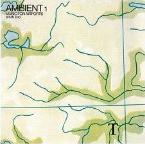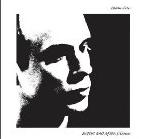Brian Peter George St. John le Baptiste de la Salle Eno has led a multi-faceted life. To modern rock fans he's perhaps best known as the imaginative producer of U2's, David Bowie's, and Talking Heads' most adventurous work, and secondarily remembered as an early and eccentric member of Roxy Music. To new age and techno fans, he's the de facto inventor of the ambient music genre. Pop fans can thank him for the best work by James, Coldplay, and Ultravox. Punk fans owe him one for No New York's introduction of the four most iconic No Wave Bands.
His collaborations with Harold Budd (favorite: The Pearl), Robert Fripp (favorite: (no pussyfooting)), David Byrne (the groundbreaking My Life in the Bush of Ghosts), John Cale (especially the delightful Wrong Way Up), and others sometimes find him as much a facilitator as a creator, yet still have an ineffable Eno-ness to them. He's also written books and computer software and shot videos -- not MTV-style, but abstract video art installations visually analogous to his music.
Far from the sort of facile, adept instrumental technician rife in the progressive rock era in which he came to prominence, Eno was fascinated with experimental music. Though his image in Roxy Music was as the most flamboyantly glam of glam rockers, garbed in garish boas and leather and slathered in makeup, he was at the same time exploring the serious experiments of Cornelius Cardew, Steve Reich, and John Cage. He was even involved in the oddball Portsmouth Sinfonia, an orchestra that deliberately used rank amateurs to play through familiar classical music in utterly shambolic fashion to find a new sort of beauty on the other side.
Though he has never cut his ties, even as a performer, to the world of rock and pop, with quirky warpings of mainstream concepts appearing at unpredictable intervals, Eno's most lasting musical contribution is probably his ambient work. Influenced conceptually by early 20th century French composer Erik Satie and by 1960s Minimalists, most notably LaMonte Young and Steve Reich, Eno's ambient music is, in his words, "a new way of hearing music -- as part of the ambience of the environment just as the colour of the light and the sound of the rain [are] parts of that ambience."
Here's a highly subjective appreciation/ranking of the highlights of the work that came out solely under his own name.
 1. Ambient 1: Music for Airports (1978)
1. Ambient 1: Music for Airports (1978)
This highly influential album kick-started the Ambient genre Eno had single-handedly started a few years before, and also gave it its name. Similar to Minimalism, but with considerably less insistent rhythms, the four pieces here repeat simple motifs against each other, with the separate parts overlapping at different points. The intent was to produce soothing background music more interesting on observation than mere Muzak. Eno constructed it in the studio using tape loops, but there's also been an instrumental realization by a classical ensemble.
 2. Another Green World (1975)
2. Another Green World (1975)
The most perfectly realized of Eno's pop-leaning albums. Tracks with prog-rock icons (Genesis drummer Phil Collins, King Crimson guitarist Robert Fripp, Brand X bassist Percy Jones, Velvet Underground violist John Cale) include the abrasive "Sky Saw," the darkly percolatingl "Over Fire Island," the catchy, nostalgic "St. Elmo's Fire" (with a bubbling, buzzing Fripp solo), and the like. Elsewhere Eno sometimes plays everything himself, highly atmospheric (yet still rhythmic) instrumental ditties with moods so specific they can practically be tasted and smelled.
 3. Before and After Science (1977)
3. Before and After Science (1977)
This album has a split personality. What was side one of the original LP mostly offers forcefully skewed rock; "No one receiving" is downright funky (showing one source of the Talking Heads' Remain in Light sound). Side two is mellower, basking in a hazy nostalgia often tinged with bittersweet ambivalence. The simplicity of the lovely "By this River" (utilizing the talents of Cluster) is breathtaking.
4. Music for Films (1978)
Eno and film scoring were an inevitable confluence, and his contributions to the soundtracks of movies by Derek Jarman and others extend his ambient interests. This collection of instrumental tracks, many under two minutes long, is seemingly built around a desire to display particular sounds. Shorn of the images they supported on-screen, they conjure meditative mindsets.
5. Apollo: Atmospheres & Soundtracks (1983)
Written to accompany Al Reinert's Apollo moon missions documentary For All Mankind, which used film shot in space by the astronauts themselves, this is hands-down Eno's most sonically gorgeous album. It's built around electric piano and synthesizers, with pedal steel guitar, the simplest bass lines, and backwards electric guitar added for spice at various points, all swathed in billowing reverb. Sometimes there are floating melodies (the sustained tones of "An Ending (Ascent)" have a noble, poised elegance); often there are a much sparer arrangements full of space (no pun intended).
 6. Here Come the Warm Jets (1973)
6. Here Come the Warm Jets (1973)
Eno's debut as a leader is the closest he came to making a "normal" pop album -- often much more throbbingly loud and insistent than most of his work. Though somewhat uneven, it includes suc high points as Robert Fripp's twisting, screaming guitar solo on "Baby's on Fire," the early-Lou Reed-like "Cindy Tells Me," and the anthemic title track.
7. Another Day on Earth (2005)
Eno's recording focus in recent decades has been largely on ambient music, but this return to making pop music under his own name is full of brilliant songwriting and his usual adventurous approach when it's his own work he's producing. Just when you think it's soothing, he undercuts the mood with subtly discomfiting touches.
8. Discreet Music (1975)
The tracks on Discreet Music are similar to the "process music" of the early Minimalists. The half-hour-long title track is the first example, really, of Eno's move into ambient music, with a few simple themes looped around each other at different intervals. Three Variations on the Canon in D major by Johann Pachelbel applies a similar process -- but in real-time performance -- to small parts of the famous Pachelbel Canon, with the different orchestral sections gradually lapsing further and further from the original's synchronization of their parts.
9. Shutov Assembly (1992)
Paradoxically, though it was created over the course of six years, this is one of Eno's most cohesive projects, avoiding the tangents and contrasts of some other albums. It's very much an ambient effort, a cross between the aural space landscapes of Apollo and the loops of Music for Airports.
10. Neroli (1993)
So ethereal it's nearly ephemeral, Neroli (subtitled Thinking Music Part IV) consists of one 58-minute ambient track built around the most minimal thematic material. It's the sonic equivalent of lying half-conscious as tantilizingly almost-recognizable impressions and sensations drift along the edges of perception.
